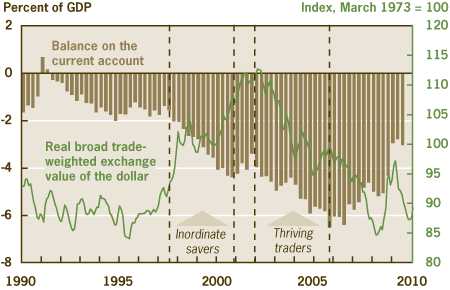- Share
The Foreign Savings Glut: Inordinate Savers or Thriving Traders?
In the years prior to our recent economic crisis, foreign savings poured into the United States. Did foreign traders who happened to acquire dollars from American trade defi cits merely choose to keep these funds in dollar-denominated assets? Or, did foreigners decide to increase their savings inordinately and place those funds in dollar-denominated assets? The answer is key to the debate about the sources of liquidity that paved the way to our recent economic problems.
The views authors express in Economic Commentary are theirs and not necessarily those of the Federal Reserve Bank of Cleveland or the Board of Governors of the Federal Reserve System. The series editor is Tasia Hane. This paper and its data are subject to revision; please visit clevelandfed.org for updates.
In the years prior to our recent economic crisis, foreign savings poured into the United States. Did foreign traders who happened to acquire dollars from American trade deficits merely choose to keep these funds in dollar-denominated assets? Or, did foreigners decide to increase their savings inordinately and place those funds in dollar-denominated assets? The answer is key to the debate about the sources of liquidity that paved the way to our recent economic problems.
A lively debate has arisen over the contribution that foreign savings may have made to our current economic problems. Some economists argue that a glut of foreign savings flowed into the United States and helped to inflate the U.S. housing bubble, whose bursting caused the financial turmoil that led to our recent recession. To be sure, in the decade before the U.S. housing bust in 2006, foreign savings poured into the United States. The savings-glut hypothesis, however, implies that the foreigners providing the influx of funds were “inordinate savers,” who placed their wealth in U.S. assets, as opposed to “thriving traders,” who acquired and held on
to a substantial quantity of dollar-denominated assets. The distinction is subtle, but key to the debate.
Each of these behaviors leaves a distinct footprint on our exchange rates and balance of payments, so these data might help to tell the tale. When inordinate foreign savings is driving events, a dollar appreciation will accompany an expanding current-account deficit. When thriving foreign traders hold sway, a dollar depreciation will go hand-in-hand with a growing current-account deficit. Both patterns have appeared in our accounts over the years, but the data leading up to the bursting of the housing bubble does not seem consistent with the savings-glut hypothesis. From early 2002 through late 2005, the dollar depreciated broadly as the U.S. current-account deficit grew, suggesting that thriving foreign traders, not inordinate foreign savers, determined events.
Current-Account Basics
A one-to-one correspondence exists between a nation’s current-account balance and the financial flows that cross its borders. In 2008, when the United States ran a $706 billion current-account deficit, it also experienced a $706 billion net inflow of foreign funds, ignoring measurement error. That same year, China maintained a $426 billion current-account surplus and experienced a net financial outflow of equivalent size. This fundamental correspondence comes about whether driven by domestic-consumption choices—and trade—or by foreign-savings decisions.
The United States has run a current-account deficit almost continuously since 1982. When our imports exceed our exports, we pay for the surfeit of imports by offering the rest of the world financial claims against our future output. These financial claims consist of such things as stocks, bonds, Treasury securities, and bank accounts. Private individuals and businesses across the globe hold most of these claims, but foreign governments, their central banks, and international organizations take up a good portion. The issuance of these financial claims creates a net fl ow of foreign savings into the United States, which, in the absence of measurement error, must exactly equal our current-account deficit. Should the flow of foreign savings ever start to diverge from the accumulating current-account deficit, exchange rates—and possibly other economic variables—will adjust to maintain the accounting identity between the two.
In contrast to the United States, China has run a current account surplus almost consistently since 1990. Prior to 2004, that surplus was fairly small, but since then it has expanded sharply. When Chinese traders export more goods and services than they import, they receive foreign currency in payment for the balance. China then invests these earnings in foreign-currency-denominated assets, thereby channeling the funds back into the financial markets of the countries whose assets it holds. Dollar assets, for example, guide Chinese savings into the United States; euro assets direct Chinese savings into Europe; yen assets channel Chinese savings into Japan. Because the Chinese government limits the ability of private individuals and businesses to invest funds abroad and instead requires them to exchange foreign currencies for renminbi with its central bank, much of this recycling occurs through official channels. Foreign financial claims become official reserve assets. That does not matter for our story; the funds still represent Chinese savings that return to foreign financial markets. Economists estimate that China holds somewhere between 60 percent and 70 percent of its official reserves in dollar-denominated assets, implying that most of these savings head back into the United States.
So far, I have discussed the fundamental correspondence between current-account deficits or surpluses and net financial inflows or outflows as if the financial flows always responded to the developments in the current account, but this need not be the case. For myriad reasons, foreigners often elect—independent of trade—to increase their savings and to channel those funds into U.S. financial instruments. U.S. financial instruments are liquid and relatively risk free, and the dollar is the key international currency. With roughly 88 percent of all foreign-exchange transactions across the globe involving dollars, having a portfolio of dollars is useful. When foreigners channel their savings into dollars, the inflow of foreign funds produces a current account deficit in the United States, through a mechanism that I will explain below.
While the correspondence between the current-account deficit and the inflow of foreign savings is always one-to-one, whether initiated by a U.S. desire to import goods from the rest of the world (resulting in those thriving foreign traders) or by a foreign desire to place savings in dollar denominated financial assets (initiated by those inordinate foreign savers), the exchange-rate response is fundamentally different in each case. When expanding U.S. imports drive the process, the dollar will depreciate in foreign-exchange markets, but when an inflow of foreign savings triggers the process, the dollar will appreciate. Working backwards—observing how the dollar behaved when the current-account deficit expanded—provides a clue about whether a domestic consumption choice or a foreign savings decision kicked off the subsequent sequence of events. It allows us to determine whether an inflow of foreign savings stemmed from inordinate foreign savers or thriving foreign traders.
Savings Glut
To be sure, there is ample evidence for the saving-glut hypothesis. In the decade before the housing crisis, foreign savings increased significantly. This growth in savings manifested itself in a substantial expansion of foreign current-account surpluses across the globe. While the phenomenon was widespread, developing and emerging market economies—particularly those in Asia—accounted for the lion’s share.
In large part, precautionary motives drove their desire for more savings. Following a series of global financial crises in the late 1990s, emerging and developing countries, notably China, Indonesia, Malaysia, South Korea, and Thailand, began to build official foreign-exchange reserve buffers against the prospects of future financial chaos. They did this in large measure by promoting domestic growth through exports, often keeping exchange rates artificially low, but by whatever means it occurred, higher savings were associated with expanding current-account surpluses in their countries. Between 2001 and 2005, according to IMF data, the surplus among emerging market and developing economies increased nine fold.
While developing and emerging-market economies led the way, the large developed countries, notably Japan and Germany, followed step. Between 2001 and 2005, their current account surpluses also grew. Many of these countries have aging populations who are saving for retirement.

A huge share of these foreign savings entered U.S. financial markets, which helped to keep interest rates lower, and investment spending higher, than otherwise would have been the case. Indeed, nominal and real long-term interest rates—whether because of foreign savings, monetary ease, or both—were lower between 2001 and 2005 than they had been since the early 1960s. Financial innovations helped channel these funds into the housing market, where abundant financing at low interest rates encouraged leveraging and risk taking.
The saving-glut hypothesis, as noted, implies that the foreigners providing the influx of funds were savers who placed their wealth into U.S. assets as opposed to traders, who acquired and held a substantial quantity of dollar denominated assets.
Telltale Footprints
While both the inordinate-foreign-savers story and the thriving-foreign-traders scenario produce an expanding current-account deficit, they have opposite impacts on the dollar. If inordinate foreign savers want to place their funds in dollar-denominated assets, they must first purchase dollars in the foreign-exchange market. Their purchases will drive the dollar’s exchange value higher. As the dollar appreciates, the foreign-currency prices of U.S. exports rise and the dollar prices of U.S. imports fall. These price changes shift worldwide demand away from U.S. goods, causing the U.S. current-account deficit to expand and maintaining the one-to-one correspondence between foreign financial inflows and our current-account deficit.
In contrast, when U.S. residents decide to buy more foreign made goods and services, thereby allowing foreign traders to thrive, they first must sell dollars and buy foreign currencies. These transactions cause the dollar to depreciate in exchange markets. The dollar’s depreciation improves the foreign-currency return on U.S. financial instruments, enticing those foreigners who acquire dollars through trade to hold them in U.S. financial assets. The dollar’s depreciation also insures that the inflow of foreign savings exactly matches an expanding current-account deficit.
Both patterns have appeared over the past few decades. Foreign savings shot into the United States from mid-1997 through 2000, during the dot-com boom. As they acquired dollar-denominated assets, foreign savers forced a 16 percent real—or inflation-adjusted—appreciation of the dollar against a broad array of our key trading partners. The real appreciation shifted worldwide demand away from U.S. traded goods and increased the current-account deficit by a full 2 percentage points of GDP (see figure 1). In contrast, the configuration of dollar and current-account movements that developed after the 2001 recession and before the 2006 real estate bust points to domestic-demand growth—not inordinate foreign savings—as a key causal development. From late 2001 through the end of 2005, the dollar depreciated 13 percent. Over this same time period, the U.S. current-account deficit again rose by 2 percentage points of GDP.
To be sure, more foreign savings flowed into the United States between late 2001 and late 2005 than between 1997 and 2000, but a tsunami of foreign savings did not come washing up on our shores. Between 2001 and 2005, developments in this country seemed to attract the foreign savings in. Expanding domestic demand increased imports and led to a dollar depreciation, which made U.S. financial assets attractive to those thriving foreign traders who were earning dollars.
Recommended Reading
- “The Global Savings Glut and the U.S. Current Account Defi cit,” by Ben S. Bernanke. Speech to the Virginia Association of Economists, March 10, 2005.
- “The Fed Didn’t Cause the Housing Bubble,” by Alan Greenspan. Wall Street Journal, March 11, 2009.
- “A Hitchhiker’s Guide to the U.S. Current Account Problem,” by Owen F. Humpage. Federal Reserve Bank of Cleveland, Economic Commentary, October 1, 2004.
- “The Financial Crisis and the Policy Responses: An Empirical Analysis of What Went Wrong,” by John Taylor. Keynote Address at Bank of Canada, November 2008.
Suggested Citation
Humpage, Owen F. 2010. “The Foreign Savings Glut: Inordinate Savers or Thriving Traders?” Federal Reserve Bank of Cleveland, Economic Commentary 2010-03. https://doi.org/10.26509/frbc-ec-201003
This work by Federal Reserve Bank of Cleveland is licensed under Creative Commons Attribution-NonCommercial 4.0 International





